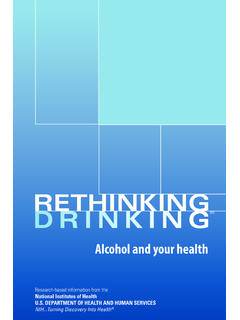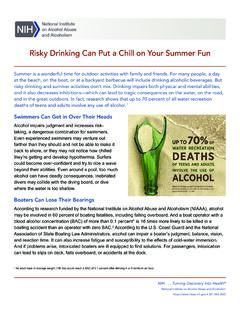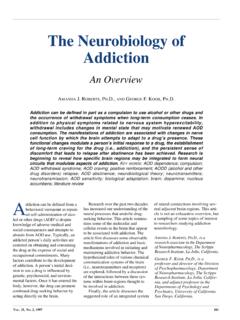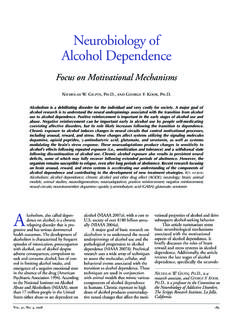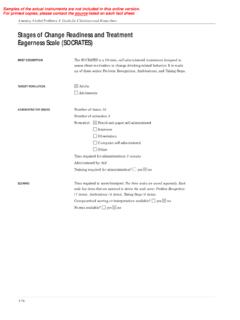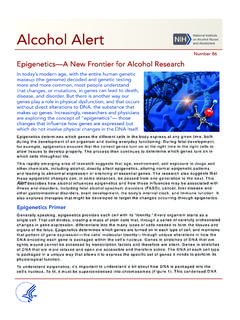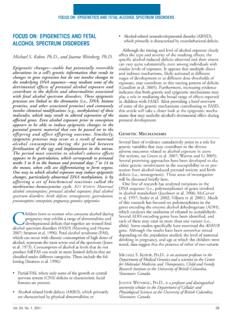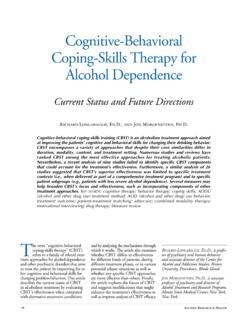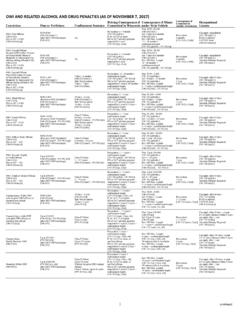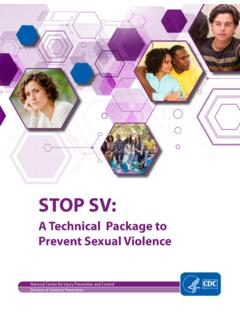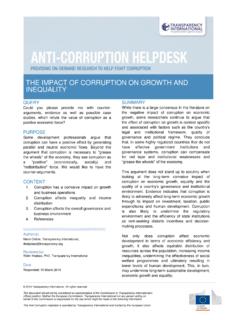Transcription of Relapse Prevention - National Institutes of Health
1 Relapse Prevention An Overview of Marlatt's Cognitive-Behavioral Model Mary E. Larimer, , Rebekka S. Palmer, and G. Alan Marlatt, Relapse Prevention (RP) is an important component of alcoholism treatment. The RP model proposed by Marlatt and Gordon suggests that both immediate determinants ( , high-risk situations, coping skills, outcome expectancies, and the abstinence violation effect) and covert antecedents ( , lifestyle factors and urges and cravings) can contribute to Relapse . The RP model also incorporates numerous specific and global intervention strategies that allow therapist and client to address each step of the Relapse process. Specific interventions include identifying specific high-risk situations for each client and enhancing the client's skills for coping with those situations, increasing the client's self-efficacy, eliminating myths regarding alcohol's effects, managing lapses, and restructuring the client's perceptions of the Relapse process.
2 Global strategies comprise balancing the client's lifestyle and helping him or her develop positive addictions, employing stimulus control techniques and urge- management techniques, and developing Relapse road maps. Several studies have provided theoretical and practical support for the RP model. KEY WORDS: AODD (alcohol and other drug dependence) Relapse ; Relapse Prevention ; treatment model; cognitive therapy; behavior therapy; risk factors; coping skills; self efficacy; expectancy; AOD (alcohol and other drug). abstinence; lifestyle; AOD craving; intervention; alcohol cue; reliability (research methods);. validity (research methods); literature review R.
3 Elapse, or the return to heavy cess, a series of events that unfold over alcohol use following a period of time (Annis 1986; Litman et al. 1979; MARY E. LARIMER, , is a research abstinence or moderate use, occurs Marlatt and Gordon 1985). According assistant professor of psychology, REBEKKA S. in many drinkers who have undergone to these models, the Relapse process PALMER is a graduate student in clinical alcoholism treatment. Traditional alco- begins prior to the first posttreatment psychology, and G. ALAN MARLATT, holism treatment approaches often alcohol use and continues after the initial , is a professor of psychology at the conceptualize Relapse as an end-state, a use.
4 This conceptualization provides Addictive Behaviors Research Center, negative outcome equivalent to treatment a broader conceptual framework for Department of Psychology, University of failure. Thus, this perspective considers intervening in the Relapse process to Washington, Seattle, Washington. only a dichotomous treatment out- prevent or reduce Relapse episodes and come that is, a person is either absti- thereby improve treatment outcome. Preparation of this manuscript was sup- nent or relapsed. In contrast, several This article presents one influential ported by National institute on Alcohol models of Relapse that are based on model of the antecedents of Relapse and Abuse and Alcoholism grants R3A AA.
5 Social-cognitive or behavioral theories the treatment measures that can be 05591 to G. Alan Marlatt and 5RO1 . emphasize Relapse as a transitional pro- taken to prevent or limit Relapse after AA 10772 03 to Mary E. Larimer. Vol. 23, No. 2, 1999 151. treatment completion. This Relapse pre- description of the development, theo- response to these situations, as well as vention (RP) model, which was devel- retical underpinnings, and treatment backward to examine the lifestyle fac- oped by Marlatt and Gordon (1985) and components of the RP model, see Dimeff tors that increase the drinker's exposure which has been widely used in recent and Marlatt 1998; Marlatt 1996; to high-risk situations.
6 Based on this years, has been the focus of considerable Marlatt and Gordon 1985). A central careful examination of the Relapse pro- research. This article reviews various aspect of the model is the detailed clas- cess, the therapist then devises strate- immediate and covert triggers of Relapse sification ( , taxonomy) of factors or gies to target weaknesses in the client's proposed by the RP model, as well as situations that can precipitate or con- cognitive and behavioral repertoire and numerous specific and general interven- tribute to Relapse episodes. In general, the thereby reduce the risk of Relapse . tion strategies that may help patients RP model posits that those factors fall avoid and cope with Relapse -inducing into two categories: immediate determi- situations.
7 The article also presents nants ( , high-risk situations, a per- Immediate Determinants of Relapse studies that have provided support for son's coping skills, outcome expectancies, the validity of the RP model. and the abstinence violation effect) and High-Risk Situations. A central con- covert antecedents ( , lifestyle imbal- cept of the RP model postulates that ances and urges and cravings). high-risk situations frequently serve as Overview of the RP Model Treatment approaches based on the the immediate precipitators of initial RP model begin with an assessment of alcohol use after abstinence (see figure 1). Marlatt and Gordon's (1985) RP model the environmental and emotional char- According to the model, a person who is based on social-cognitive psychology acteristics of situations that are potentially has initiated a behavior change, such as and incorporates both a conceptual associated with Relapse ( , high-risk alcohol abstinence, should begin expe- model of Relapse and a set of cognitive situations).
8 After identifying those riencing increased self-efficacy or mas- and behavioral strategies to prevent or characteristics, the therapist works for- tery over his or her behavior, which limit Relapse episodes (for a detailed ward by analyzing the individual drinker's should grow as he or she continues to Decreased Effective coping Increased probability of response self-efficacy Relapse High-risk situation Decreased self-efficacy Abstinence and violation Ineffective Lapse (initial effect and Increased positive coping use of perceived probability outcome response alcohol) positive of Relapse expectancies for effects of effects of alcohol alcohol Figure 1 The cognitive-behavioral model of the Relapse process posits a central role for high-risk situations and for the drinker's response to those situations.)
9 People with effective coping responses have confidence that they can cope with the situation ( , increased self-efficacy), thereby reducing the probability of a Relapse . Conversely, people with ineffective coping responses will experience decreased self-efficacy, which, together with the expectation that alcohol use will have a positive effect ( , positive outcome expectancies), can result in an initial lapse. This lapse, in turn, can result in feelings of guilt and failure ( , an abstinence violation effect). The abstinence violation effect, along with positive outcome expectancies, can increase the probability of a Relapse . NOTE: This model also applies to users of drugs other than alcohol.
10 152 Alcohol Research & Health Relapse Prevention : Marlatt's Cognitive-Behavioral Model maintain the change. Certain situations ( , using willpower to limit con- an initial lapse) and a return to uncon- or events, however, can pose a threat sumption), and nonspecific cravings trolled drinking or abandonment of to the person's sense of control and, also were identified as high-risk situ- the abstinence goal ( , a full-blown consequently, precipitate a Relapse cri- ations that could precipitate Relapse . Relapse ). Although research with vari- sis. Based on research on precipitants of ous addictive behaviors has indicated Relapse in alcoholics who had received Coping.
